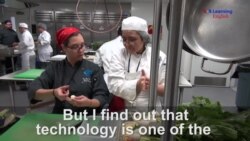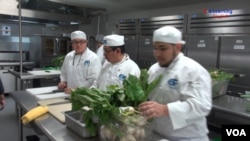"They face the same challenges that any immigrants face: a different language, a different culture. They have left behind the whole world that they know: their neighbors, their parents, their kids, their friends, their whole identity. And they came looking for the American dream, to learn - and in the end they only need a chance."
Chef Ben Velasquez is talking about the students at Carlos Rosario International Public Charter School. He says that local governments in the U.S. must teach students at least to a high school level. But immigrants may come as adults. They may come from a country where they did not receive the same educational opportunities.
So when immigrants come to the U.S., they may have a hard time finding work. If they don't speak English well, or if they lack job-specific skills, then employers may not want to hire them.
Immigrants often find work in service industries like hotels, restaurants, and personal care. These workers do not need college degrees, but they must have job-specific skills and English language skills.
Some U.S. public schools provide English language instruction and job-specific training to adult immigrants in separate adult education programs.
One such school is Carlos Rosario International Public Charter School.
In 1998, the school became the first adult public charter school in the United States.
Preparing to be a chef
The Culinary Arts program has progressed beyond its simple beginnings. The founder of the Culinary Arts program is Emilia Rivera. When she started the program, she brought pots and pans from her house to teach her students how to make soups and stews. The school now has state of the art kitchens.
The culinary arts program has three classes: Culinary Arts Fundamentals, International Cuisine, and Baking and Pastries.
In the Culinary Arts Program, students first take a course called "Culinary Arts Fundamentals." This course has theoretical and hands-on elements.
In the first semester, students learn the basic, fundamental areas of culinary arts. Students learn about the history of food, the names of kitchen tools and equipment, and the names of spices.
They also learn knife skills and how to balance a meal. Balancing a meal means choosing the correct kind of protein, starch and vegetables for a meal.
Students learn how to measure. The United States uses a different system of measurement than most countries in the world. Students learn how many fluid ounces are in a cup, in a quart, or in a gallon, among other measurements.
Then, in the next six months, students begin to apply what they have learned. They learn how to make stocks and sauces; they learn how to make protein such as chicken, fish and meat.
Teachers instruct students in mise en place, a French expression, which means how to prepare food before it is cooked.
"…how to peel, how to have everything ready. Cooking is easy, but peeling onions, chopping onions, slicing onions, dicing onions; preparing tomatoes for the next preparation, that is what’s really time consuming. And in French that is called mise en place. So students learn."
By the end of the first year, Chef Velazquez says, students are prepared to take a job as an entry-level chef in a restaurant.
The second course in the culinary arts program, "International Cuisine", lasts five months. It focuses on the cuisines of different cultures around the world – European, South American, and Asian.
Chef Velazquez says that his students often have a weakness when they start school: they are not familiar with technology. Velazquez says that technology is one of the biggest barriers to students trying to reach their full potential.
"… learning is a process that doesn't really stop. We all learn new things every single solitary day. But I find out that technology is one of the biggest setbacks for them to really reach all of their potential."
Because of this, the culinary arts program teaches students basic technology skills. Students learn to use common office applications.
Now, even cooks have to be familiar with technology. Chefs order from produce providers on the computer and customers make reservations online. Restaurants depend on customer reviews and social media to promote their business.
Certifications and connecting skills to jobs
The school prepares students to take a test leading to national certification in safe food handling. The National Restaurant Association sponsors the certification, called ServSafe.
Many health departments require the ServSafe certificate. Students who pass the test can work in kitchens in Washington DC, or in different states around the U.S.
Students at Carlos Rosario can work for other certifications that show the job skills they have learned. One graduate has earned the Certified Executive Chef certification, the same as a Bachelor's Degree in cooking.
The importance of community
The element of support is critical to the school's mission.
Chef Velazquez told a story about how the school substitutes for the friends and family members the student left behind.
One day, around 2 o'clock, a student came to see Chef Velazquez. She asked him if she could stay at the school that afternoon. The other employees left the room, says Velazquez, and he closed the door.
"Listen, the employees went to the cafeteria, tell me what happened. And she started crying, but she was happy, it was not sad, she was happy. And she said "you know what I just came from Baltimore… I became a United States Citizen today. And I don't have any other place to go and celebrate." She feels that the school is her home. So, we both cried, you know, because, it was a very emotional moment. That tells you how these students feel this school is their home. We are their family. And I said "thank you very much for coming and sharing that information with us. Now, you can vote."
Citizenship is another goal that students can reach with the help of the school. Classes meet regularly at Carlos Rosario to prepare students to take the examination for becoming a naturalized citizen of the U.S.
An upcoming article will tell the story of two students in the Culinary Arts program at Carlos Rosario.
I'm Jill Robbins.
John Russell reported on this story for VOA Learning English. Mario Ritter was the editor.
_______________________________________________________
Words in This Story
culinary –adj. related to cooking
state of the art – adj. using or having the most modern methods, knowledge, or technology
fundamental - adj. forming or relating to the most important part of something
potential –adj. possible, able to become real
application –n. a computer program, such as a word processing program
reservation –n. an informal agreement to be at a place like a restaurant at a certain time
certification –n. to receive an official document stating you have a skill or can do some kind of job
What special training do you have? What would you like to learn? Write to us in the Comments Section









